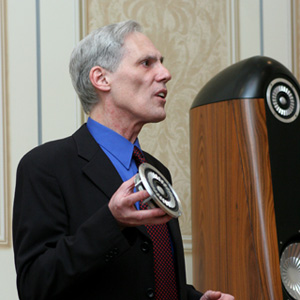 |
| February 1, 2006 Audiophile Technology Wars at CES 2006 Press materials abounded at this year’s Consumer Electronics Show. Over the course of four days, I compiled a stack of marketing materials more than a foot thick -- and dumped them all into my hotel trashcan before heading off to the airport on Sunday night. I’d gathered them because, when it came time to write captions for the SoundStage! Network CES show report on SoundStage! AV, I needed to make sure I had the details correct. Although I was most interested in model names and prices, the main thrust of these materials was the shiny new technology each company was employing in its latest products. This is nothing new -- each year, "breakthroughs" are announced that will seemingly revolutionize the industry. The problem with touting such technologies is that they don’t, in and of themselves, prove that the products are any good. We don’t listen to component parts or to a single technology per se, but to the totality of a design. How does the average audiophile separate real breakthroughs in materials, parts, and design from marketing drivel created to blind you with "science"? The only way to know how something actually performs is to test its performance -- pure and simple. Is that too simplistic a case to make? I don’t think so. If you’re an audiophile, you must listen to the product. The important thing to keep in mind is that you’re listening to the whole design rather than to any individual part. Thiel’s take Jim Thiel, of Thiel Audio, introduced at the 2006 CES his company’s new CS3.7 loudspeaker -- by the company’s own admission, the most radical Thiel design to date. Its predecessor, the CS3.6, dates all the way back to the early 1990s. The driver configurations are new -- as implemented in the CS3.7, Thiel’s coincident midrange-tweeter array is, according to Jim Thiel, quite an advance. The driver diaphragms themselves -- which, in the case of the midrange, is flat -- are ribbed in a way that reportedly increases their stiffness, which produces a more linear frequency response by avoiding cone breakup modes. The CS3.7 seems to include some real progress over past Thiel designs -- the theories propounded by Jim Thiel at least seem to be based on hard research and science. Or did Thiel Audio just have the sexiest marketing?
But wouldn’t beryllium be needed to produce state-of-the-art high frequencies? Or how about diamond? That trumps beryllium, right? The questioner apparently knew that many companies are marketing these exotic driver materials as evidence that their designs have moved past their competitors’ products. Perhaps so -- I’m no engineer. But what about Jim Thiel’s claims? Thiel speakers do, each time I hear them, sound quite good. Driver materials no doubt address certain performance parameters. Drivers can be tested in many different ways, and can be implemented in a design in more ways than that. So what matters most? There’s no way an audiophile such as I can sort these things out -- except by listening and, as a secondary mode of research, examining good third-party measurements, such as the ones produced for SoundStage! I do recall overhearing a conversation that theorized on the marketing of tweeter-diaphragm material. One large company had just introduced a beryllium tweeter, and so their primary competitor had to counter with diamond just to keep the marketing department happy. How much fact there is in this tweeter competition I can’t say. The timing of the respective product launches supports the allegation, however. A message to product manufacturers: At the end of the day, I want exotic sound; exotic marketing is optional. If a new technology you’re using to get from point A to point B is better, prove it by producing better sound. If you can’t do that convincingly, then perhaps at your company it’s the marketing department that calls the tune. ...Jeff Fritz
Ultra Audio is part of the SoundStage! Network. |
 The most interesting part of the Thiel
press conference, however, was when an attendee asked why Thiel doesn’t use beryllium
in their tweeters, instead of the aluminum the company has used for some time. I found Jim
Thiel’s response refreshing and profound. To paraphrase: Beryllium is expensive to
produce, and the money it would cost for the incremental increase in performance could be
spent elsewhere for far greater gains. Essentially, the customer’s money could be
spent more wisely in other places.
The most interesting part of the Thiel
press conference, however, was when an attendee asked why Thiel doesn’t use beryllium
in their tweeters, instead of the aluminum the company has used for some time. I found Jim
Thiel’s response refreshing and profound. To paraphrase: Beryllium is expensive to
produce, and the money it would cost for the incremental increase in performance could be
spent elsewhere for far greater gains. Essentially, the customer’s money could be
spent more wisely in other places.